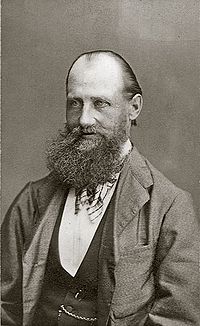Ferdinand von Wright
Ferdinand von Wright (born March 19, 1822 in Haminalahti near Kuopio , Finland , † July 31, 1906 there ) was a Finnish painter and graphic artist .
Life
Like his two older brothers Magnus von Wright and Wilhelm von Wright , he devoted himself to depicting birds. He was also known for his landscape and portrait painting as well as still lifes .
Ferdinand von Wright spent his childhood on his parents' estate Haminalahti near Kuopio. His parents were Major Henrik Magnus von Wright and Marie Elisabeth b. Tuderus. Ferdinand was their fifteenth and youngest child. Six of the children died soon after they were born. In addition to Magnus and Wilhelm, the brothers Fredrik, Adolf, Julius (grandfather of the philosopher Georg Henrik von Wright ) and the sisters Wilhelmina, Fredrika and Rosalie survived . The family is originally from Scotland; the progenitor Georg Wright settled as a merchant in Narva in the middle of the 17th century .
Ferdinand received school education mainly from his parents and private tutors. His mother tongue was Swedish, although he read and spoke Finnish fluently. Like his brothers, Ferdinand spent a long life hunting and in nature.
His artistic talent became apparent early on. As a sketchbook shows, he was already working with bird drawings as a ten-year-old. At that time his brothers Magnus and Wilhelm were already known in this field. Ferdinand traveled to Sweden for the first time when he was fifteen and moved to live with his brother Wilhelm von Wright in the Bohuslän province . Wilhelm worked there as an illustrator for the animal researcher Prof. BF Fries. In 1838 he traveled to Mörkö near Stockholm and worked for the ornithologist Nils Bonde, for whom his brothers had already illustrated his work on Swedish birds ("Svenska Foglar"). Ferdinand returned to Haminalahti with his two brothers Magnus and Wilhelm at short notice and after a few months moved back to Sweden, this time for almost six years. There he studied temporarily in 1842 at the Art Academy with the Swedish sculptor Johan Niclas Byström .
In 1844 Ferdinand moved back to Haminalahti. Around 1849 he studied for some time in the city of Turku with the Finnish portrait painter Robert Wilhelm Ekman .
In 1852 Ferdinand traveled to his brother Magnus in Helsinki, where he also moved into an apartment with Ateljé for a while. Here he refined his art and changed his style. He painted his first demanding and independent works, such as the large format "Fox and Geese".
In 1858 Ferdinand went on a study trip to Dresden for two months. His teacher was the animal painter Johann Siegwald Dahl . He then traveled to his brother Wilhelm on the west Swedish island of Orust for a year and stayed in Sweden until the spring of 1859.
In 1863 Ferdinand moved into his own house on the Haminalahti estate, where he would live and work for the next twenty years. The house was called "Lugnet" (Swedish: peace). He led a lonely, nature-loving life there as a bachelor, but without leaving the family. He also spent a few winters in the nearby city of Kuopio , where his sisters lived, among others.
In the 1970s, Ferdinand von Wright became permanently ill and was often bedridden. However, he continued his work.
In 1874 Ferdinand left for Helsinki for a few weeks. At the end of the 1970s he moved from his “Lugnet” house to the main building of the estate and moved into two rooms on the upper floor, where he would live for almost three decades. During this phase he made a number of works, mainly commissioned work. Among the later works, the "Capercaillie", painted in 1886, is probably his best-known work. He also published on his ornithological observations in some magazines.
Thorsten Waenerberg was his pupil in Haminalahti in 1864 and Berndt Lindholm a few years later. In the 1990s, the Finnish bird painter Matti Karppanen was Ferdinand's pupil and assistant in Haminalahti.
In 1881 he went on his last trip to Sweden to Orust for a month to visit his brother Wilhelm. In 1885 he was granted a state artist pension. He lived very withdrawn in Haminalahti and painted until his death in 1906.
literature
- Leikola, Lokki, Stjernberg: Taiteilijaveljekset by Wright . Helsinki 1986.
Web links
- Kuopio City Art Museum
- Finnish National Gallery, Catalog raisonné ( Memento from October 23, 2007 in the Internet Archive )
- Collection of works in the Finnish National Gallery
| personal data | |
|---|---|
| SURNAME | Wright, Ferdinand von |
| BRIEF DESCRIPTION | Finnish painter |
| DATE OF BIRTH | March 19, 1822 |
| PLACE OF BIRTH | Kuopio , Finland |
| DATE OF DEATH | July 31, 1906 |
| Place of death | Kuopio |

